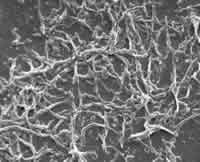| Vent Fluid Chemistry and the Microbial Habitat |

Vent Fluid Chemistry and the Microbial HabitatThe discovery of deep-sea hydrothermal systems on the Galapagos ridge 20 years ago opened up the exploration of an entire new ecosystem whose metabolic energy is derived at least partially from the earth's internal heat rather than from the sun. The primary producers in this system are the wide variety of Bacteria and Archaea that utilize sulfur, hydrogen, methane and other compounds released by the reactions between seawater and magma beneath the 60,000 km-long Midocean Ridge system and other centers of seafloor volcanism. Some of the most intriguing of these microbes are the thermophilic and hyperthermophilic Archaea, some of which have optimal growth rates at temperatures exceeding 100°C. The Archaea have specialized enzymes to cope with and thrive in this extreme temperature and pressure regime. These "extremozymes" are of great interest to the biotechnology community for many industrial applications, and the deep-sea hydrothermal vent organisms are of particular interest because of the high pressure/high temperature environment. Because microbial metabolism must derive energy by mediating thermodynamically favorable chemical reactions, it is axiomatic that the chemical and physical environment will have a direct impact on the type of organisms that can exist there. In an oversimplified view, favorable conditions for microbial growth in hydrothermal systems depend on the confluence of electron donors (reduced compounds derived from high-temperature water-rock interaction) and electron acceptors (more oxidized compounds present in seawater or interstitial water flowing below the seafloor) within a temperature range that is tolerable to microorganisms. This temperature range extends up to at least 110°C. Some of the reactions that microbes can mediate in submarine hydrothermal systems are shown in Figure 6, from Butterfield et al. 1997. Conditions below the sea floor in hydrothermal systems are ripe for microbial production. It is very likely that different types of fluid chemistry will give rise to different microbial populations, but very little work has been done on this in submarine hydrothermal systems. The figure above depicts chemical and microbial processes in a diffuse upflow zone. Injection of a magma dike results in delivery of reduced volatile compounds and metals through outgassing and water-rock interaction. Phase separation partitions volatiles and some metals into the vapor phase, and brines accumulate around heat source. The thermal and redox gradient provides a zone for chemical and microbial oxidation of reduced gases and metals as circulating seawater is entrained (microbial methanogenesis and sulfur reduction are known to occur at 110 C). (From Figure 6, Butterfield et al. 1997, Philosophical Transaction of the Royal Society, vol 355.)
For more information on this topic, the following papers are recommended as a starting point: Jannasch, H. W. 1995 Microbial interaction with hydrothermal fluids. In Seafloor Hydrothermal Systems: Physical, Chemical, Biological, and Geological Interactions (ed. S. E. Humphris et al.), pp. 273-296. Washington D.C.: American Geophysical Union. Karl, D. M. 1995 Ecology of free-living, hydrothermal vent microbial communities. In The Microbiology of Deep-Sea Hydrothermal Vents (ed. D. M. Karl), pp. 35-125. Boca Raton: CRC Press. D. A. Butterfield, I. R. Jonasson, G. J. Massoth, R. A. Feely, K.K. Roe, R. E. Embley, J. F. Holden, R. E. McDuff, M. D. Lilley, and J. R. Delaney 1997 Seafloor eruptions and evolution of hydrothermal fluid chemistry. Phil. Trans. R. Soc. Lond. A., 355, 369-386. |

